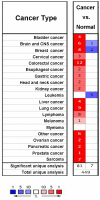Bioinformatics analysis revealing prognostic significance of RRM2 gene in breast cancer
- PMID: 30898978
- PMCID: PMC6454020
- DOI: 10.1042/BSR20182062
Bioinformatics analysis revealing prognostic significance of RRM2 gene in breast cancer
Abstract
Background: Ribonucleotide reductase M2 subunit (RRM2) plays vital roles in many cellular processes such as cell proliferation, invasiveness, migration, angiogenesis, senescence, and tumorigenesis. However, the prognostic significance of RRM2 gene in breast cancer remains to be investigated. Methods:RRM2 expression was initially evaluated using the Oncomine database. The relevance between RRM2 level and clinical parameters as well as survival data in breast cancer was analyzed using the Kaplan-Meier Plotter, PrognoScan, and Breast Cancer Gene-Expression Miner (bc-GenExMiner) databases. Results:RRM2 was overexpressed in different subtypes of breast cancer patients. Estrogen receptor (ER) and progesterone receptor (PR) were negatively correlated with RRM2 expression. Conversely, the Scarff-Bloom-Richardson (SBR) grade, Nottingham prognostic index (NPI), human epidermal growth factor receptor-2 (HER-2) status, nodal status, basal-like status, and triple-negative status were positively related to RRM2 level in breast cancer samples with respect to normal tissues. Patients with increased RRM2 showed worse overall survival, relapse-free survival, distant metastasis-free survival, disease-specific survival, and disease-free survival. RRM2 also exerted positive effect on metastatic relapse event. Besides, a positive correlation between RRM2 and KIF11 genes was confirmed. Conclusion: Bioinformatics analysis revealed that RRM2 might be used as a predictive biomarker for prognosis of breast cancer. Further studies are needed to more precisely elucidate the value of RRM2 in evaluating breast cancer prognosis.
Keywords: Biomarker; Breast cancer; Prognosis; RRM2.
© 2019 The Author(s).
Conflict of interest statement
The authors declare that there are no competing interests associated with the manuscript.
Figures





Similar articles
-
Bioinformatics analysis of prognostic significance of COL10A1 in breast cancer.Biosci Rep. 2020 Feb 28;40(2):BSR20193286. doi: 10.1042/BSR20193286. Biosci Rep. 2020. PMID: 32043519 Free PMC article.
-
Identification of prognostic significance of BIRC5 in breast cancer using integrative bioinformatics analysis.Biosci Rep. 2020 Feb 28;40(2):BSR20193678. doi: 10.1042/BSR20193678. Biosci Rep. 2020. PMID: 32043523 Free PMC article.
-
Bioinformatics analysis of prognostic value of TRIM13 gene in breast cancer.Biosci Rep. 2019 Mar 22;39(3):BSR20190285. doi: 10.1042/BSR20190285. Print 2019 Mar 29. Biosci Rep. 2019. PMID: 30837324 Free PMC article.
-
LEP as a potential biomarker in prognosis of breast cancer: Systemic review and meta analyses (PRISMA).Medicine (Baltimore). 2021 Aug 20;100(33):e26896. doi: 10.1097/MD.0000000000026896. Medicine (Baltimore). 2021. PMID: 34414945 Free PMC article.
-
Cancer Fighting SiRNA-RRM2 Loaded Nanorobots.Pharm Nanotechnol. 2020;8(2):79-90. doi: 10.2174/2211738508666200128120142. Pharm Nanotechnol. 2020. PMID: 32003677 Review.
Cited by
-
Celastrol induces ferroptosis by suppressing RRM2 in hepatocellular carcinoma.Heliyon. 2024 Jul 2;10(13):e33936. doi: 10.1016/j.heliyon.2024.e33936. eCollection 2024 Jul 15. Heliyon. 2024. PMID: 39071636 Free PMC article.
-
[PRMT1 inhibits apoptosis of nasopharyngeal carcinoma cells by promoting RRM2 expression].Nan Fang Yi Ke Da Xue Xue Bao. 2022 Dec 20;42(12):1783-1790. doi: 10.12122/j.issn.1673-4254.2022.12.05. Nan Fang Yi Ke Da Xue Xue Bao. 2022. PMID: 36651245 Free PMC article. Chinese.
-
Screening of traditional Chinese medicine monomers as ribonucleotide reductase M2 inhibitors for tumor treatment.World J Clin Cases. 2022 Nov 6;10(31):11299-11312. doi: 10.12998/wjcc.v10.i31.11299. World J Clin Cases. 2022. PMID: 36387821 Free PMC article.
-
Screening Hub Genes as Prognostic Biomarkers of Hepatocellular Carcinoma by Bioinformatics Analysis.Cell Transplant. 2019 Dec;28(1_suppl):76S-86S. doi: 10.1177/0963689719893950. Epub 2019 Dec 11. Cell Transplant. 2019. PMID: 31822116 Free PMC article.
-
RRM2 expression in different molecular subtypes of breast cancer and its prognostic significance.Diagn Pathol. 2022 Jan 5;17(1):1. doi: 10.1186/s13000-021-01174-4. Diagn Pathol. 2022. PMID: 34986845 Free PMC article.
References
-
- Li J., Pang J., Liu Y., Zhang J., Zhang C., Shen G.. et al. (2018) Suppression of RRM2 inhibits cell proliferation, causes cell cycle arrest and promotes the apoptosis of human neuroblastoma cells and in human neuroblastoma RRM2 is suppressed following chemotherapy. Oncol. Rep. 40, 355–360 - PubMed
Publication types
MeSH terms
Substances
LinkOut - more resources
Full Text Sources
Other Literature Sources
Medical
Research Materials
Miscellaneous

